Agriculture is attempting to prepare itself to face the many new challenges being brought about by changes to policy and legislation, in the form of the CAP, nitrates, climate, biodiversity, environment, pesticides, fertiliser, emissions, etc.
The big focus is clearly going to be on reducing emissions, forcing producers to become as close to carbon neutral as is humanely possible.
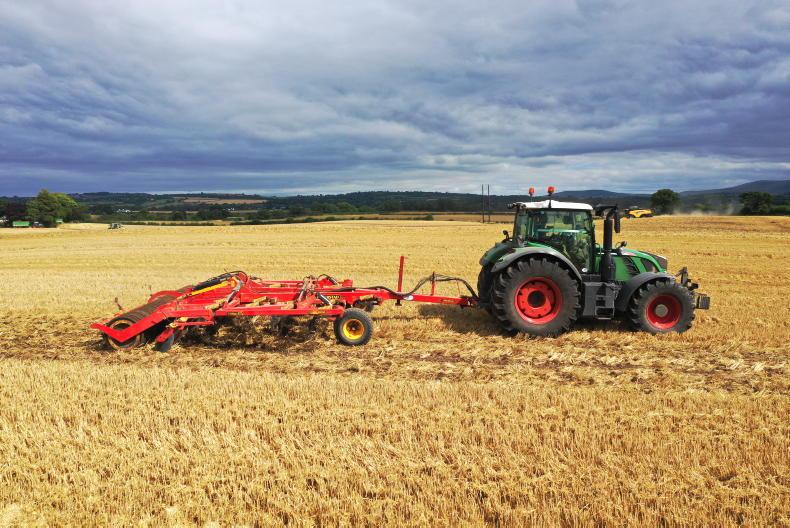
Non-inversion establishment is likely to be promoted more to help reduce carbon loss from tillage soils.
Change
Agriculture has always embraced change, but the pace of change over the next decade may happen faster than ever before.
Whether you’re a tillage farmer, a dairy farmer, or a beef or sheep farmer, all sectors have some reliance on machinery.
Over the years, machinery has been adapted to suit our visions and farming practices, regardless of the sector in hand.
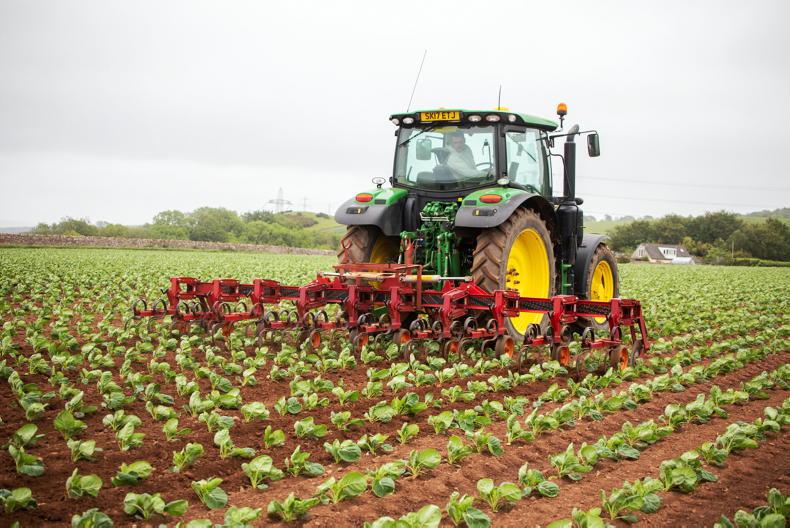
Very precise guidance systems are now being used for weed control in high-value vegetable and other crops.
In this piece, we try to envisage what this might mean for the types of machinery Irish farmers will be using into the future.
The developments in slurry equipment within the past 10 years is a prime example of how we can adapt to achieving our targets and comply with regulations. It’s not that long ago since every farmer spread slurry using the traditional splash plate – this is certainly no longer the case.
Today, all farmers in nitrates derogation or exceeding the nitrogen cut-off limit of 170kg/ha by means of exporting slurry are required to apply slurry using low-emission slurry spreading (LESS) equipment. However, many farmers who do not fall under either category still use such methods solely for their benefit, as well as the environment’s.
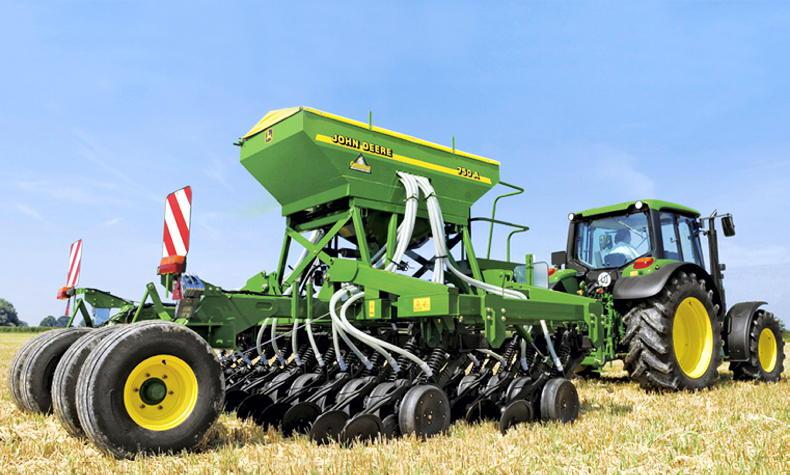
Direct drilling is being increasingly used to establish crop on soils in good health and also to enhance carbon storage options.
As most people know, there are a number of LESS systems available on the market which use dribble bars, trailing shoes or the shallow disc injection system.
Not only does LESS equipment reduce ammonia losses to the atmosphere, it also has a number of other benefits including increasing the amount of nitrogen available to the crop, increased nitrogen recovery and reduced leaf contamination. Together, these help to reduce chemical fertiliser usage and give quicker grazing turnaround times.
Grant aid under the Targeted Agricultural Modernisation Scheme (TAMS II) has been the major incentive for farmers to make the switch to such equipment, by making it much more affordable.
Slurry into the future
Looking to the future, an outright ban on splash plate application seems inevitable. It is likely that LESS equipment will become the standard requirement, with a particular focus on the trailing shoe and shallow disc injection systems.
In recent years, we’ve seen manufacturers develop near-infrared (NIR) sensing systems to analyse the constituents of both forage and slurry.
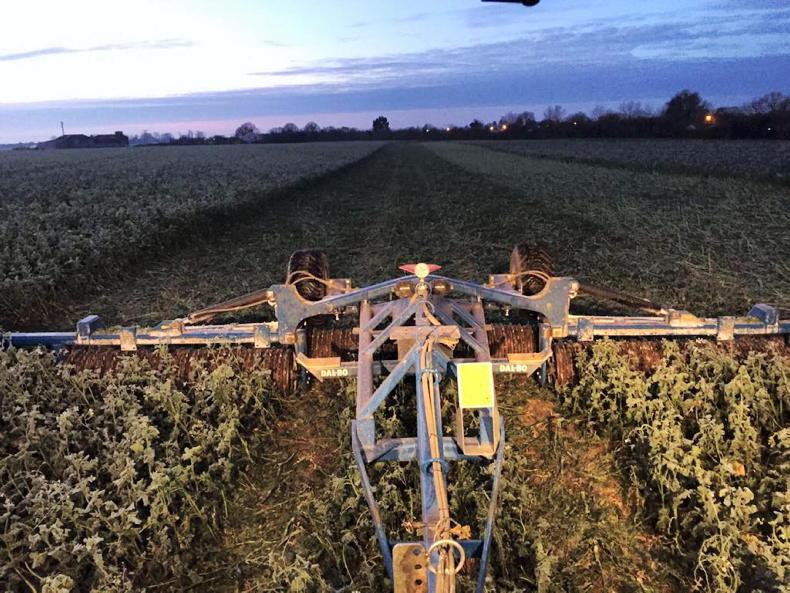
Rolling catch crops in frosty weather will help to kill the vegetation.
We have seen such technology working on tankers and umbilical systems, analysing constituents and allowing results-based decisions to be made so that the desired application rate can be achieved accurately.
A handful of farmers/contractors have taken this to the extreme of having forward speed adjusted in accordance with slurry constituents.
Alternatively, for those taking the wider precision-farming approach and carrying out yield mapping, for example, fertilisers and organic matter such as slurry can be applied variably across fields based on yield results. Such technology is not yet enforced and it is unlikely that it will be for years yet, if ever.
Separators are machines more commonly used in mainland Europe and in the UK, with few or none known to be working in Ireland. As the name suggests, such machines separate livestock slurry into the liquid and solid constituents. These machines are also used in anaerobic digestion (AD) plants for the separation of digestate.
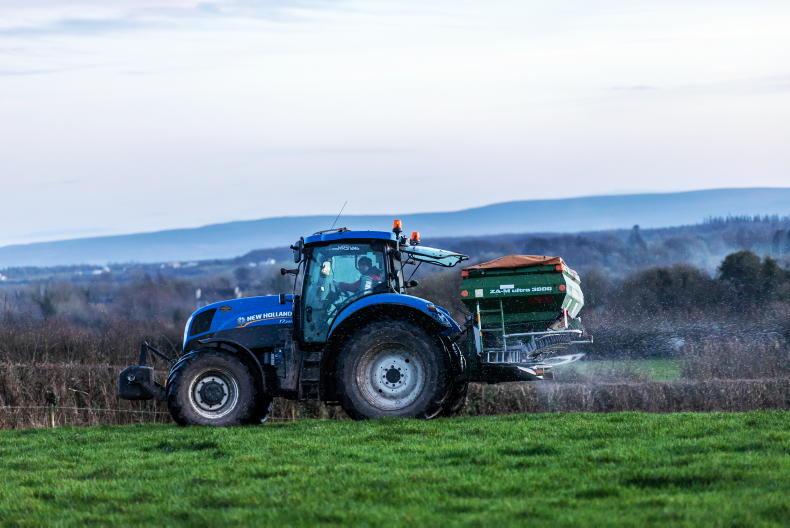
Fertiliser spreaders can now be fitted with precision farming technology to control application rate and minimise overlaps. \ Claire Nash
We feel that this is a path with good potential, especially given the most recent nitrate proposals on slurry storage and longer closed periods which are set to be implemented over the next two years. This, coupled with the proposed 60-day soiled water spreading ban, will see many farmers faced with no options but to increase storage. Research shows a dairy cow will produce up to 25l of soiled water per day, excluding rainfall, which works out into a significant amount of water when multiplied by the herd size over a 60-day period.
Separation would allow the much more efficient use of existing storage, as solids are easier to store and, in many cases, can be reused for another purpose such as animal bedding. The liquid which is then more concentrated can be stored in the tanks but this requires much less space compared to slurry, freeing up existing capacity.
When it comes to spreading, the liquid tends to offer more benefits over traditional slurry, including improved plant growth, lower levels of volatilisation, reduced contaminants and a faster uptake. This is because the highly concentrated liquid can be absorbed into the root structure much faster.
Changes
for tillage
All farming sectors will see changes to practices to help contribute to the range of new environmental and policy requirements. So how might these policy requirements change the machines used on modern Irish tillage farms?
Minimal-tillage
Farmers are being encouraged to change from routinely ploughing their tillage ground on an annual basis. This is because when we plough, some of the carbon sequestered in the soil is lost to the atmosphere through the breakdown of organic matter following the addition of air.
No-till, in addition to the growing of cover crops which ensure the soil is not bare through the winter months, improves the carbon footprint of crop production. For such reasons, we will see increased emphasis on non-inversion tillage and the associated machinery required.
The role of glyphosate
Glyphosate is a total herbicide used to kill existing vegetation prior to planting crops, both annual crops and grassland renewal. Roundup is the most common trade name for this active. Although CAP and glyphosate usage are not directly linked, if this chemical is not renewed for use next year, its loss would have a major impact on the goals of the proposed policies. Its continued availability is crucial to the advancement of min-till and direct-drill farming systems.
When we plough, we turn over the soil to get rid of existing vegetation while burying weeds and thrash. This provides a clean seedbed for the new crop to enable it to establish without competition.
However, if policy pushes us more and more towards the non-inversion route, the absence of ploughing or other cultivation means that chemical control of natural regeneration on the surface is increasingly important. It is worth noting that, in Ireland, only about 30% of glyphosate is used on tillage farms, with about 50% on grassland and the remainder used in amenity, horticulture, etc.
Mechanical weeding
The increasing pressures on chemical weed control have prompted a number of manufacturers of sprayers and/or cultivation equipment (such as Lemken and Pöttinger) to strategically invest in their own branded mechanical weeding technology.
Mechanical options are shaping up to be a reliable alternative for the future. Some manufacturers are developing camera-sensing technology for integration with these implements, to ensure absolute precision so that the crop plants are not damaged.
The choice of mechanical weeding method will depend on many things, but mainly on the crop in hand. Although not that common in Ireland yet, such methods are already used by some in the vegetable industry.
Mechanical weeders are another way of managing weeds that may be proving difficult to tackle because of resistance issues or because there are fewer chemical actives to do these jobs.
Mechanical weed control will vary from weeding the entire crop or be limited to selective inter-row weeding.
If we look to the European market, especially the organic sector, it is evident there are lots of different brands, each with several models.
This ranges from comb harrows with fixed beds of adjustable tines for weed control in cereal and rapeseed crops, to rotary hoes which generally consist of steel wheels on spring-mounted arms that break up the surface crust, removing young weeds.
Catch crop destruction
If we do lose glyphosate-based products, we will also have to look to alternate mechanical methods of catch crop destruction.
The rolling of the cover crops in early spring, which were sown the previous autumn, may provide an option to kill these crops. Frosty weather provides an ideal opportunity to roll catch crops where the opportunity arises.
Where large amounts of biomass have been successfully grown, knocking the crops in early spring can help with breakdown and nutrient release for the following crop, while the debris will help protect the soil from rain and erosion.
There are also other machines available such as cover crop roller-crimpers. These are generally made from hollow steel drums or cylinders with blades or knives attached which crimp or crush the stems of the living cover crop to help kill it.
These rollers can leave a uniform surface mulch which can suppress weeds and facilitate no-till planting. Other machines can be used in cereal crops to cut the seed heads off of flowering weeds to help prevent weed seed dispersal.
Although not as popular here in Ireland, growers across parts of Europe often practise direct drilling straight into catch crops, meaning there is no bare soil at any stage in the production cycle. But, again, this cover must be killed somehow.
Direct drilling
The use of direct drills is coming back into fashion and they can play a key role in non-inversion tillage. As the name suggests, such machines insert the seed into the soil without inverting the surface. The seed is placed in a narrow slot created by discs or coulters. Direct drilling offers potential savings over traditional crop establishment systems due to the reduced energy required, less damage to the soil’s structure and less risk of soil erosion. A big attraction is increased carbon storage and the reduced loss of carbon to the atmosphere.
The use of direct drills also has an important role to play in the future of grassland farming. They can be used to introduce the likes of clover into existing swards to help benefit carbon sequestration and growth where fertiliser N application is curtailed. They can also be used to help introduce desirable varieties into swards to help productivity if glyphosate is not available.
The widespread use of GPS systems in recent years to aid fertiliser application on Irish farms has signalled a big step forward for the industry and this is not restricted to any one sector.
In addition, recently announced TAMS II funding to allow all farmers to avail of grant aid for GPS-guided fertiliser spreaders is a further boost.
Such machines that fall under grant aid specification include rate and section control systems with automatic shut-off. This, in turn, has made farms more efficient and contributed to a more environmentally sustainable farming model.
The big question is, will farmers be required to record the precise placement of fertiliser from each application in the future?
Given the way technology is developing, such a task will be possible in the future, although such a requirement would be outside of the capability, and cost-effectiveness, of many smaller farms. Might such smaller farmers be given a VAT or tax write-off to employ the services of contractors for such a task?
Although some may argue this is quite futuristic thinking, the industry is advancing very quickly and we will have to adopt many such changes to meet climate targets in the near future.
Agriculture is attempting to prepare itself to face the many new challenges being brought about by changes to policy and legislation, in the form of the CAP, nitrates, climate, biodiversity, environment, pesticides, fertiliser, emissions, etc.
The big focus is clearly going to be on reducing emissions, forcing producers to become as close to carbon neutral as is humanely possible.

Non-inversion establishment is likely to be promoted more to help reduce carbon loss from tillage soils.
Change
Agriculture has always embraced change, but the pace of change over the next decade may happen faster than ever before.
Whether you’re a tillage farmer, a dairy farmer, or a beef or sheep farmer, all sectors have some reliance on machinery.
Over the years, machinery has been adapted to suit our visions and farming practices, regardless of the sector in hand.

Very precise guidance systems are now being used for weed control in high-value vegetable and other crops.
In this piece, we try to envisage what this might mean for the types of machinery Irish farmers will be using into the future.
The developments in slurry equipment within the past 10 years is a prime example of how we can adapt to achieving our targets and comply with regulations. It’s not that long ago since every farmer spread slurry using the traditional splash plate – this is certainly no longer the case.
Today, all farmers in nitrates derogation or exceeding the nitrogen cut-off limit of 170kg/ha by means of exporting slurry are required to apply slurry using low-emission slurry spreading (LESS) equipment. However, many farmers who do not fall under either category still use such methods solely for their benefit, as well as the environment’s.

Direct drilling is being increasingly used to establish crop on soils in good health and also to enhance carbon storage options.
As most people know, there are a number of LESS systems available on the market which use dribble bars, trailing shoes or the shallow disc injection system.
Not only does LESS equipment reduce ammonia losses to the atmosphere, it also has a number of other benefits including increasing the amount of nitrogen available to the crop, increased nitrogen recovery and reduced leaf contamination. Together, these help to reduce chemical fertiliser usage and give quicker grazing turnaround times.
Grant aid under the Targeted Agricultural Modernisation Scheme (TAMS II) has been the major incentive for farmers to make the switch to such equipment, by making it much more affordable.
Slurry into the future
Looking to the future, an outright ban on splash plate application seems inevitable. It is likely that LESS equipment will become the standard requirement, with a particular focus on the trailing shoe and shallow disc injection systems.
In recent years, we’ve seen manufacturers develop near-infrared (NIR) sensing systems to analyse the constituents of both forage and slurry.

Rolling catch crops in frosty weather will help to kill the vegetation.
We have seen such technology working on tankers and umbilical systems, analysing constituents and allowing results-based decisions to be made so that the desired application rate can be achieved accurately.
A handful of farmers/contractors have taken this to the extreme of having forward speed adjusted in accordance with slurry constituents.
Alternatively, for those taking the wider precision-farming approach and carrying out yield mapping, for example, fertilisers and organic matter such as slurry can be applied variably across fields based on yield results. Such technology is not yet enforced and it is unlikely that it will be for years yet, if ever.
Separators are machines more commonly used in mainland Europe and in the UK, with few or none known to be working in Ireland. As the name suggests, such machines separate livestock slurry into the liquid and solid constituents. These machines are also used in anaerobic digestion (AD) plants for the separation of digestate.

Fertiliser spreaders can now be fitted with precision farming technology to control application rate and minimise overlaps. \ Claire Nash
We feel that this is a path with good potential, especially given the most recent nitrate proposals on slurry storage and longer closed periods which are set to be implemented over the next two years. This, coupled with the proposed 60-day soiled water spreading ban, will see many farmers faced with no options but to increase storage. Research shows a dairy cow will produce up to 25l of soiled water per day, excluding rainfall, which works out into a significant amount of water when multiplied by the herd size over a 60-day period.
Separation would allow the much more efficient use of existing storage, as solids are easier to store and, in many cases, can be reused for another purpose such as animal bedding. The liquid which is then more concentrated can be stored in the tanks but this requires much less space compared to slurry, freeing up existing capacity.
When it comes to spreading, the liquid tends to offer more benefits over traditional slurry, including improved plant growth, lower levels of volatilisation, reduced contaminants and a faster uptake. This is because the highly concentrated liquid can be absorbed into the root structure much faster.
Changes
for tillage
All farming sectors will see changes to practices to help contribute to the range of new environmental and policy requirements. So how might these policy requirements change the machines used on modern Irish tillage farms?
Minimal-tillage
Farmers are being encouraged to change from routinely ploughing their tillage ground on an annual basis. This is because when we plough, some of the carbon sequestered in the soil is lost to the atmosphere through the breakdown of organic matter following the addition of air.
No-till, in addition to the growing of cover crops which ensure the soil is not bare through the winter months, improves the carbon footprint of crop production. For such reasons, we will see increased emphasis on non-inversion tillage and the associated machinery required.
The role of glyphosate
Glyphosate is a total herbicide used to kill existing vegetation prior to planting crops, both annual crops and grassland renewal. Roundup is the most common trade name for this active. Although CAP and glyphosate usage are not directly linked, if this chemical is not renewed for use next year, its loss would have a major impact on the goals of the proposed policies. Its continued availability is crucial to the advancement of min-till and direct-drill farming systems.
When we plough, we turn over the soil to get rid of existing vegetation while burying weeds and thrash. This provides a clean seedbed for the new crop to enable it to establish without competition.
However, if policy pushes us more and more towards the non-inversion route, the absence of ploughing or other cultivation means that chemical control of natural regeneration on the surface is increasingly important. It is worth noting that, in Ireland, only about 30% of glyphosate is used on tillage farms, with about 50% on grassland and the remainder used in amenity, horticulture, etc.
Mechanical weeding
The increasing pressures on chemical weed control have prompted a number of manufacturers of sprayers and/or cultivation equipment (such as Lemken and Pöttinger) to strategically invest in their own branded mechanical weeding technology.
Mechanical options are shaping up to be a reliable alternative for the future. Some manufacturers are developing camera-sensing technology for integration with these implements, to ensure absolute precision so that the crop plants are not damaged.
The choice of mechanical weeding method will depend on many things, but mainly on the crop in hand. Although not that common in Ireland yet, such methods are already used by some in the vegetable industry.
Mechanical weeders are another way of managing weeds that may be proving difficult to tackle because of resistance issues or because there are fewer chemical actives to do these jobs.
Mechanical weed control will vary from weeding the entire crop or be limited to selective inter-row weeding.
If we look to the European market, especially the organic sector, it is evident there are lots of different brands, each with several models.
This ranges from comb harrows with fixed beds of adjustable tines for weed control in cereal and rapeseed crops, to rotary hoes which generally consist of steel wheels on spring-mounted arms that break up the surface crust, removing young weeds.
Catch crop destruction
If we do lose glyphosate-based products, we will also have to look to alternate mechanical methods of catch crop destruction.
The rolling of the cover crops in early spring, which were sown the previous autumn, may provide an option to kill these crops. Frosty weather provides an ideal opportunity to roll catch crops where the opportunity arises.
Where large amounts of biomass have been successfully grown, knocking the crops in early spring can help with breakdown and nutrient release for the following crop, while the debris will help protect the soil from rain and erosion.
There are also other machines available such as cover crop roller-crimpers. These are generally made from hollow steel drums or cylinders with blades or knives attached which crimp or crush the stems of the living cover crop to help kill it.
These rollers can leave a uniform surface mulch which can suppress weeds and facilitate no-till planting. Other machines can be used in cereal crops to cut the seed heads off of flowering weeds to help prevent weed seed dispersal.
Although not as popular here in Ireland, growers across parts of Europe often practise direct drilling straight into catch crops, meaning there is no bare soil at any stage in the production cycle. But, again, this cover must be killed somehow.
Direct drilling
The use of direct drills is coming back into fashion and they can play a key role in non-inversion tillage. As the name suggests, such machines insert the seed into the soil without inverting the surface. The seed is placed in a narrow slot created by discs or coulters. Direct drilling offers potential savings over traditional crop establishment systems due to the reduced energy required, less damage to the soil’s structure and less risk of soil erosion. A big attraction is increased carbon storage and the reduced loss of carbon to the atmosphere.
The use of direct drills also has an important role to play in the future of grassland farming. They can be used to introduce the likes of clover into existing swards to help benefit carbon sequestration and growth where fertiliser N application is curtailed. They can also be used to help introduce desirable varieties into swards to help productivity if glyphosate is not available.
The widespread use of GPS systems in recent years to aid fertiliser application on Irish farms has signalled a big step forward for the industry and this is not restricted to any one sector.
In addition, recently announced TAMS II funding to allow all farmers to avail of grant aid for GPS-guided fertiliser spreaders is a further boost.
Such machines that fall under grant aid specification include rate and section control systems with automatic shut-off. This, in turn, has made farms more efficient and contributed to a more environmentally sustainable farming model.
The big question is, will farmers be required to record the precise placement of fertiliser from each application in the future?
Given the way technology is developing, such a task will be possible in the future, although such a requirement would be outside of the capability, and cost-effectiveness, of many smaller farms. Might such smaller farmers be given a VAT or tax write-off to employ the services of contractors for such a task?
Although some may argue this is quite futuristic thinking, the industry is advancing very quickly and we will have to adopt many such changes to meet climate targets in the near future.











 This is a subscriber-only article
This is a subscriber-only article










SHARING OPTIONS: